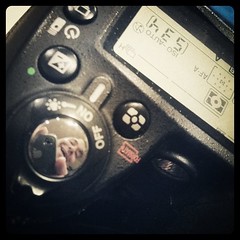Spot vs. Matrix Metering

1/125th of a sec | f/2.8 | 50mm | ISO 200
When a lot of people get a DSLR, a setting that they tend to overlook is the type of metering. Most cameras come set to Matrix metering by default and that’s where it stays. There’s a good reason for that – Matrix metering handles most situations really well. So why would you venture into the world of spot metering?

Shot on the iPhone with Instagram – never mind the goof in the shutter’s reflection
When I’m shooting something like people outdoors or indoors with a very strong directional ambient light source (like a window), spot metering is the way to go. In the photo up at the top of this post, birthday girl Caitlyn smiles for a split second for me. In this type of situation, I’ve got the camera in aperture priority mode, and the metering set to spot. Why? Well, I shoot in aperture priority mode because there are kids hopped up on birthday cake – this means largest possible aperture to get the fastest shutter speed because they are bouncing around like heated up Mexican jumping beans. There is also a huge window wall with the sun blaring right through it. For me this means I need to try to put my subject between the light source and my lens, preferably at a slight angle to get some sidelight.

1/250th of a sec | f/2.8 | 50mm | ISO 200
In order to not have the camera meter for the brighter background, I use spot metering and focus on my subject to get a meter reading off of their face. This will blow out the background, but that is perfectly accepted in today’s photography as it helps isolate your subject. The face and eyes are the important part of these photos, so that is all I care about in regards to exposure.

1/125th of a sec | f/2.8 | 50mm | ISO 200
Matrix metering was designed to address this kind of shooting, but like any automatic mode it lacks the intuitive decision process of the human mind. It will try and properly expose your subject, and a lot of the time it will not get too fooled by the brighter background because it will use a database of different shooting situations to guess what you are trying to do. But, it will try not to overexpose any part of the photo, so there is a chance that it will slightly underexpose your main subject. I know with spot metering that I will get the result I’m looking for each and every time. The real trick is to remember to switch it back from spot to matrix when you’re done shooting!